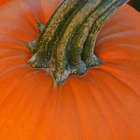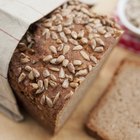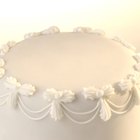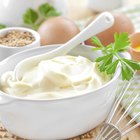
Pungent-flavored vinegar seems like an unusual ingredient to use in baking, but vinegar's chemical properties make it a baking star. From creating fluffier cakes to making perfect meringues, vinegar is a versatile baker's helper. Learning vinegar's uses and secrets can save you time and avert baking disasters, for only pennies per use.
The Type is Right
White vinegar is one of the most common types of vinegars used in baking, with a simple, mellow flavor. It's produced by distilling alcoholic spirits from grains like rye and corn. Cider vinegar, crafted from fermenting apples, has a fruity flavor and is slightly sweeter than white vinegar. Neither of these two types will leave any lingering vinegary tastes behind in cakes or breads. Balsamic vinegar, which is made from unfermented grape syrup, is another option, but due to its stronger flavor, save it for recipes that specifically call for it.
Rise and Shine
One of the most important roles of vinegar in baking is to react with baking soda, creating carbon dioxide gas that helps cakes and cookies rise as they bake. To boost homemade bread dough rising, add 1 tablespoon of vinegar for every 2 1/2 cups flour in a recipe. If you have soft water, which can weaken gluten in dough, a little vinegar will also improve bread quality. Vinegar can help frosting, too -- a scant 1/2 teaspoon vinegar added to homemade frosting makes it creamy and glossy.
Call in the Substitute
If you've ever started a recipe and realized that you are out of buttermilk, vinegar can come to the rescue. Add 1 tablespoon of vinegar and milk to a measuring cup, let it stand five minutes, and use as you would buttermilk. Vinegar can also stand in for lemon by adding 1/2 teaspoon vinegar in place of each 1 teaspoon of lemon juice in the recipe. To use vinegar instead of wine, dilute 1 part vinegar to 2 parts water.
But Wait, There's More
Add 1/2 teaspoon of vinegar for every three egg whites to make meringue that is fluffier and more stable. The vinegar prevents the meringue from collapsing by reducing the number of bonds formed between egg proteins. Vinegar brushed over a loaf of homemade bread a few minutes before the end of the baking cycle will help produce a golden brown crust. Likewise, adding a little vinegar to pie dough will result in a tender, flaky crust. If a fruit pie or other dessert turns out overly sweet, just add a pinch or two of vinegar to balance the flavors.
Related Articles

What Happens When Vinegar & Yeast Are ...

Uses for Vinegar on Toes

Can You Use Malt Vinegar in Place of ...

How to Make Pumpkin Bread Moist

Russian Rye Bread vs. Pumpernickel

How to Measure the Acidity of Homemade ...

What to Substitute for Mirin

Can You Substitute Yogurt for Milk in ...

Does It Matter if I Substitute Baking ...

Why Does Milk Curdle When it Is Mixed ...

Emergency Substitutions for Cream of ...

Baking Soda Vs. Cream of Tartar

How to Make a White Decorator Icing

How to Make Bread Tender

How to Replace Eggs With Mayonnaise

Vinegar as a Body Cleanse

A List of Leavening Agents
Role of Xanthan Gum in Vegan Baking

How to Remove Eyeglass Coating With ...

What Works With Baking Soda Besides ...
References
Writer Bio
Bonnie Singleton has been writing professionally since 1996. She has written for various newspapers and magazines including "The Washington Times" and "Woman's World." She also wrote for the BBC-TV news magazine "From Washington" and worked for Discovery Channel online for more than a decade. Singleton holds a master's degree in musicology from Florida State University and is a member of the American Independent Writers.
Photo Credits
Hemera Technologies/PhotoObjects.net/Getty Images